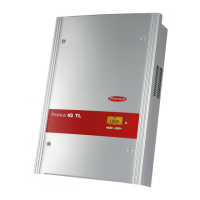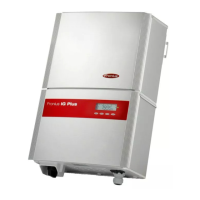25
EN-US
Choosing the Location
Choosing the lo-
cation in general
Please note the following criteria when choosing a location for the inverter:
Choosing a Loca-
tion for Inside In-
stallation
Installation only on a solid vertical wall:
- min. 3 ft. (0.9 m) above the ground
- max. 6.5 ft. (2 m) above the ground
Max. ambient temperatures: -13 °F / +122 °F (-25 °C / +50 °C)
Relative humidity: 0 - 95 %
For use at altitudes above sea level: up to 6561 ft. (2000 m)
- Keep a minimum distance of 8 in. (20 cm) between each inverter or anything to the
right or left of the inverters such as walls or DC and AC disconnects.
For optimal airflow and cooling efficiency in locations with temperatures exceeding
104 °F (40 °C), the manufacturer recommends a distance of 10 - 12 in. (25 - 30 cm).
- When installing more than one inverter, keep a distance of 12 in. (30 cm) between
each inverter. In locations with temperatures exceeding 104 °F (40 °C), more than
12 inches is desirable..
The air flow direction within the inverter is from left to right (cold air intake on left, hot air
exit on right).
No objects are to be located within a distance of 6 in. around the air vents on both sides
of the inverter.
When installing the inverter in a switch panel cabinet (or similar closed environment), it is
necessary to make sure that the hot air that develops will be discharged by forced venti-
lation.
The inverter is designed for installation both indoors and outdoors..
During certain operation phases the inverter may produce a slight noise. For this reason
it should not be installed in an occupied living area.
Do not install the inverter in:
- areas with large amounts of dust
- areas with large amounts of conducting dust particles (e.g., iron filings)
- areas with corrosive gases, acids or salts
- areas where there is an increased risk of accidents, e.g., from farm animals (horses,
cattle, sheep, pigs, etc.)
- stables or adjoining areas
- storage areas for hay, straw, chaff, animal feed, fertilizers, etc.
- storage or processing areas for fruit, vegetables or winegrowing products
- areas used in the preparation of grain, green fodder or animal feeds
- greenhouses

